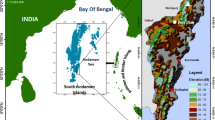Abstract
Applying the concept of "analogue studies" long used in reservoir characterization, outcrop analogues in two aquifer units of Southern Germany have been investigated: Upper Triassic (Keuper) alluvial sandstones (Stubensandstein) and Quaternary glaciofluvial gravels. Architectural element analysis of the outcrops is combined with ground-penetrating radar profiles derived a few meters behind the outcrop walls. Such calibration is used to better understand the three-dimensional sedimentary architecture. Many sedimentary units at the same time represent hydraulic flow units and are characterized by specific radar signatures. This approach leads to promising results, not only in unconsolidated aquifers but also in fully consolidated sedimentary rocks. Our studies will lead to a database with which more realistic predictions of the hydraulic behaviour of sedimentary aquifers systems, needed for numerical hydrogeological simulations, will be possible.
Similar content being viewed by others
Author information
Authors and Affiliations
Additional information
Received: 17 June 1996 · Accepted: 12 August 1996
Rights and permissions
About this article
Cite this article
Asprion, U., Aigner, T. Aquifer architecture analysis using ground-penetrating radar: Triassic and Quaternary examples (S. Germany). Environmental Geology 31, 66–75 (1997). https://doi.org/10.1007/s002540050165
Issue Date:
DOI: https://doi.org/10.1007/s002540050165



